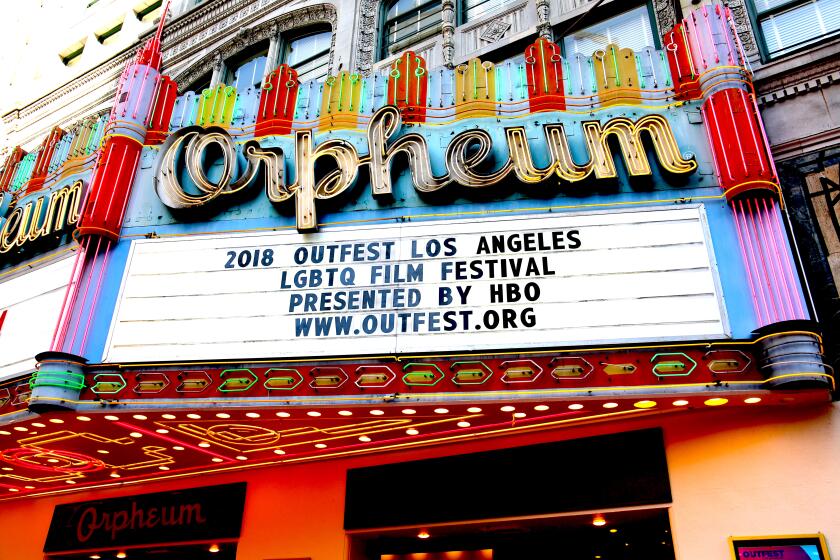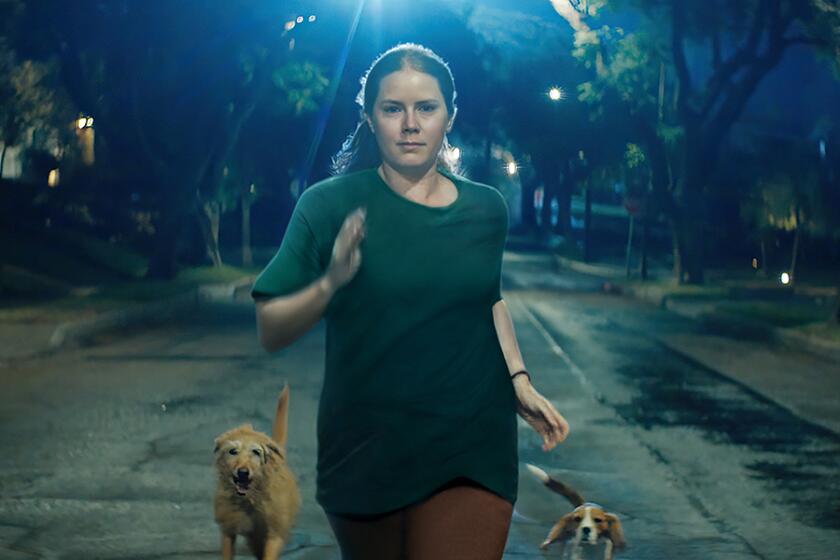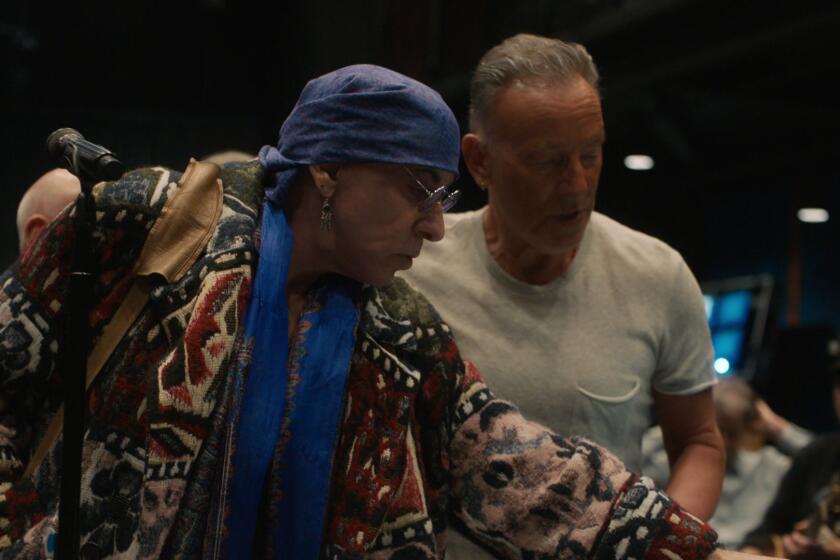TIFF Critics Notebook: ‘A Beautiful Day in the Neighborhood,’ ‘Uncut Gems’ shake up festival rhythms
- Share via
TORONTO — In “A Beautiful Day in the Neighborhood,” Marielle Heller’s quietly disarming new movie, Matthew Rhys plays Lloyd Vogel, an Esquire journalist tasked with writing a profile of Fred Rogers, the beloved television personality better known as Mister Rogers (played by Tom Hanks). Lloyd, a sardonic type with a misanthropic streak, approaches the assignment with reluctance and annoyance. Not known for going easy on his celebrity subjects, he isn’t particularly interested in Fred’s unfashionable brand of kindness, and he suspects, deep down, that it might in fact be a false front, a sugarcoated lie that generations of American children have swallowed whole.
I don’t mean to project, but Lloyd’s initial reaction to Fred — irritated, bored, bewildered — couldn’t help but remind me of the skepticism with which critics sometimes respond, or are thought to respond, to a particular kind of art. I don’t mean to reinforce the bogus wisdom that we’re all unrepentant cynics, that we go into each screening certain that we are about to experience something insincere at best, phony at worst. Only that it is perhaps in our nature to be skeptical of movies that traffic in feel-good bromides, to wince at stories that try to elicit tears and sniffles with too heavy a hand.
I myself approached “A Beautiful Day in the Neighborhood” with equal parts wariness and optimism — a bit concerned, perhaps, about an actor as sanctified as Tom Hanks playing a figure as sanctified as Fred Rogers, but also confident that a director with as deft and thoughtful a touch as Heller (“The Diary of a Teenage Girl,” “Can You Ever Forgive Me?”) might be up to more than biopic business as usual. And while it seemed obvious enough where the story would go — that Lloyd’s encounter with Fred would ultimately prove personally therapeutic, even transformative — there was reason to hope that the movie might find a fresh, novel route to that destination.
I needn’t have worried. From the opening scene of Hanks in a red cardigan, doing a nearly pitch-perfect rendition of the “Mister Rogers’ Neighborhood” theme song, to the clever use of scene transitions that resemble landscapes from the Neighborhood of Make-Believe, Heller’s movie (written by Micah Fitzerman-Blue and Noah Harpster) is a sweet, playful and humorous tribute to its famous subject. Fred’s scenes with Lloyd — a fictionalized stand-in for the journalist Tom Junod, who profiled Rogers for Esquire in 1998 — play on the natural, often very funny tension between Lloyd’s anxious pessimism and Fred’s soothing calm.
But Hanks’ lovingly wrought performance is much more than just an impeccable piece of mimicry. It can be hard to take your eyes off a famous actor playing a famous person, but Hanks never seems to be hogging the camera; at times he practically slips into the background. But if you watch and listen closely, you can feel him quietly recalibrating the picture, slowing it down, gently tailoring its rhythms to his own. “A Beautiful Day in the Neighborhood” doesn’t just pay lip service to its subject; in the modesty of its form and the gentleness of its spirit, it seeks to distill and embody his very philosophy of life.
Those who saw Morgan Neville’s recent documentary “Won’t You Be My Neighbor?” may have that philosophy fresh in their minds: namely, Mr. Rogers’ belief that every child and adult in front of him deserved his undivided attention. Heller’s movie asks for that level of attention from the audience, and moment by unhurried moment, it gives the audience the same. There’s a moment when Mister Rogers asks Lloyd to share a minute of silence, and the result is one of the more extraordinary sequences I’ve seen recently: The screen goes quiet and the audience follows suit, bound with the characters under the same hushed spell.
Although audiences will get the chance to see “A Beautiful Day in the Neighborhood” when it opens Nov. 22 in theaters, encountering it amid the hubbub of Toronto is nothing short of revivifying: It feels like a gentle corrective to the nonstop hustle-and-bustle that reigns at most major international film festivals.
Off the top of my head, I can’t think of a more different picture I’ve seen at Toronto than “Uncut Gems,” the tense, agitated new movie starring Adam Sandler and directed by Josh and Benny Safdie. This movie is nothing but hustle-and-bustle. Even more so than the Safdie brothers’ 2017 thriller, “Good Time,” it’s practically a cinematic panic attack, feverishly sustained over more than two hours by two directors who never fail to get under the skin.
If “Uncut Gems” and “A Beautiful Day in the Neighborhood” have anything in common, it’s that they both take their distinct rhythmic cues from their stars. Sandler, sporting a goatee, a diamond earring and false teeth, plays Howard Ratner, a middle-aged Jewish family man who runs a jewelry shop in Manhattan’s diamond district, and whose natural, perhaps preferred condition is to be in way over his head. Howard never seems to stop talking, lying, running and hustling; he’s a mess, a marvel and a maker of uniformly terrible decisions. You want him to slow down or go away, or take a long, rejuvenating nap. You want him to hang out with Mister Rogers.
Howard does none of those things. Instead he juggles a girlfriend (Julia Fox) and a fed-up wife (Idina Menzel), scrambles to stay one step ahead of his debtors and gets caught up in a foolhardy scheme involving former NBA star Kevin Garnett (playing himself) and a large rock filled with sparkling opals. The plot is both painstakingly worked out — no one crafts a downward spiral as meticulously as the Safdies, who wrote the script with Ronnie Bronstein — and also weirdly beside the point. If one crazy digression or detour were dropped, another would quickly take its place.
Set to open Dec. 13 through A24, “Uncut Gems” is a rush, a vehicle that runs on a tank of pure, unleaded desperation. It’s a maelstrom of sweaty bodies and claustrophobic spaces, of continually raised voices in competition with each other and with the mighty electronic clamor of Daniel Lopatin’s score. What makes the movie such a cohesive vision of chaos is that it seems to take its rhythmic cues entirely from Sandler, who reminds us what a terrific actor he can be (“Punch-Drunk Love,” “The Meyerowitz Stories”) when he gets a script that calls for more than the usual idiot-comedy shtick. He goes all in.
Both Hanks and Sandler give performances that hinge on, and in some ways subvert, the viewer’s knowledge of their past work. It’s safe to say that many of those who see “Ema,” a vibrant, adventurous and intoxicatingly strange jumble of a movie from the director Pablo Larraín (“Jackie,” “Neruda”), will have little or no familiarity with the actress Mariana Di Girólamo, though they may have a desire to seek out her past work immediately. As Ema, a reggaeton dancer in her late 20s, Di Girólamo has a radiantly inscrutable screen presence, with bleached-blond hair and a stare that cuts right through you. You’ll spend most of “Ema” trying to figure out what she wants and who she is, none of which Ema and Larraín make particularly easy.
The fog clears gradually. Ema is married to the leader of her dance troupe, Gastón (Gael García Bernal), with whom she once adopted a young son who is no longer in their custody. She’s trying to get their boy back, and will do anything and seduce anyone (or everyone) in order to make that happen. In some ways, Ema is as much of a wheeler-dealer as Howard Ratner, someone who has her eye forever on some distant and improbable prize.
But the movie doesn’t just zip her along on a linear path toward her goal; it’s like a story that’s been smashed into shards and then reassembled out of order, glued together by hypnotic dance sequences that seem to speak more precisely and eloquently for Ema than any explanatory dialogue possibly could. Like some of the more memorable films at Toronto this year, “Ema” leaves you wondering what exactly you just saw, and hoping it won’t be too long before you see it again.
More to Read
Only good movies
Get the Indie Focus newsletter, Mark Olsen's weekly guide to the world of cinema.
You may occasionally receive promotional content from the Los Angeles Times.












